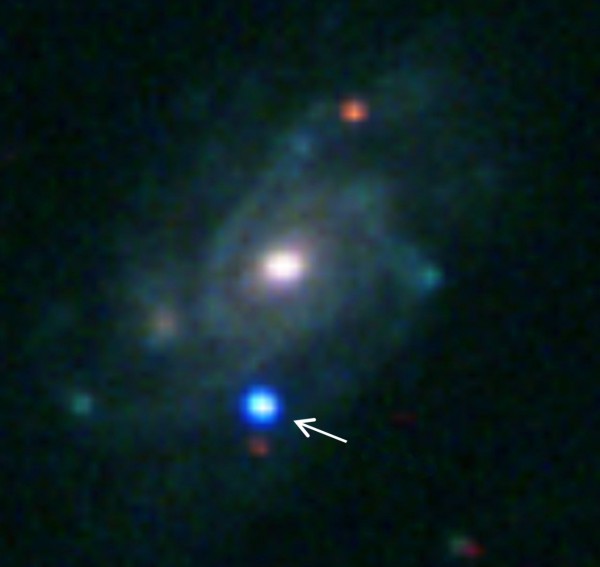The Biggest Star in the Universe Explodes Into a Supernova
| Robert Sarkanen | | May 24, 2014 09:30 AM EDT |
Artistic representation of a supernova in progress.
(Photo : Avishay Gal-Yam et al.) Picture of the new supernova taken with the iPTF observatory illustrates the brightness and scale of the explosion against the backdrop of UGC 9379, a galaxy containing billions of other stars like it.
Scientists using new sky survey technology confirmed for the first time that a star 20 times the mass of the Earth's sun exploded into a massive supernova.
The star of the so called Wolf-Rayet class, the biggest stars in existence, was situated 360 million light years away in the Bootes constellation when scientists managed to catch sight of it mere hours after exploding into a massive supernova designated SN 2013cu.
Like Us on Facebook
The observations made are believed to be a breakthrough in observing the self-destruction process of giant stars preceding the supernova stage. The findings were recently published in Nature by scientists of the Israeli Weizmann Institute of Science led by Dr. Avishay Gal-Yam.
Thanks to new developments in interstellar observation capabilities developed at the US Department of Energy, astronomers are now able to study supernovae such as SN 2013cu in nearly real time, something previously believed to be impossible due to limitations of imaging technology.
The sheer strength of the blast of similar supernovae, first discovered in 1987, previously made it impossible to study the source of the explosion as it eventually propels too much cosmic matter in the way for observation. But thanks to the new technology developed, known as the intermediate Palomar Transient Factory (iPTF), scientists were able to spot the supernova as it was first forming and track the source.
The iPTF has been described as essentially a robotic telescope, situated in Berkeley, California. The iPTF utilizes resources at the National Energy Research Scientific Computing Center (NERSC) and Energy Sciences Network (ESnet) to endlessly search for new stars and supernovae in progress. Once it finds something, it sends out signals to collaborating observatories across the world to align on the same coordinates to gather multiple observations of the same event.
This is how the SN 2013cu supernova was first caught in action before the shockwave overtook the solar winds left by its star so that astronomers could conclude the nature of the originating star.
The Wolf-Rayet star, still undesignated, was estimated to have been around 6.7 million times the mass of Earth, burning at a temperature exceeding 50 000 degrees Celsius. The exact size is hard to estimate as stars of that size are essentially believed to be gaseous clouds that are only loosely held together by the immense forces of gravity.
This leads to exceptionally powerful solar winds, with three times the mass of Earth being discarded annually at speeds of ten million miles per hour.
The Wolf-Rayet class of giant stars are considerably rare and frequently obscured by other stars, planetoids, asteroids and cosmic phenomenon. As a result, little is known about them aside from their massive size, including how they are formed and how they die out.
As with any star, this giant spent its life fusing together hydrogen elements, creating the heavier compound of helium. The resulting energy of the fusion reaction was the only thing counteracting the massive amount of gravity from making the star collapse onto itself.
As the hydrogen runs out, the fusion reaction continues with the smaller trace elements creating an iron core so dense that continued fusion is impossible and the star runs cold and implodes.
The force of the subatomic particles collapsing onto itself releases in turn the energy to cause a huge explosion known as a supernova - an explosion so powerful it briefly outshines the entire galaxy in brightness.
The energy emitted in the massive explosion lasting mere hours is the equivalent of the energy the Sun would emit over its entire lifespan lasting billions of years.
The resulting shockwave expels the contents of the star, massive amounts of cosmic gas and debris, at speeds of up to one tenth of the speed of light. This massive expulsion of heavy chemical elements reacting to one another many astronomers theorize may be the origins of the building blocks of life.
TagsWolf-Rayet, Star, Supernova, Explosion, Cosmic, Universe, Israel, Berkeley, Weizmann Institute of Science
©2015 Chinatopix All rights reserved. Do not reproduce without permission
EDITOR'S PICKS
-

Did the Trump administration just announce plans for a trade war with ‘hostile’ China and Russia?
-

US Senate passes Taiwan travel bill slammed by China
-

As Yan Sihong’s family grieves, here are other Chinese students who went missing abroad. Some have never been found
-

Beijing blasts Western critics who ‘smear China’ with the term sharp power
-

China Envoy Seeks to Defuse Tensions With U.S. as a Trade War Brews
-

Singapore's Deputy PM Provides Bitcoin Vote of Confidence Amid China's Blanket Bans
-

China warns investors over risks in overseas virtual currency trading
-

Chinese government most trustworthy: survey
-

Kashima Antlers On Course For Back-To-Back Titles
MOST POPULAR
LATEST NEWS
Zhou Yongkang: China's Former Security Chief Sentenced to Life in Prison

China's former Chief of the Ministry of Public Security, Zhou Yongkang, has been given a life sentence after he was found guilty of abusing his office, bribery and deliberately ... Full Article
TRENDING STORY

China Pork Prices Expected to Stabilize As The Supplies Recover

Elephone P9000 Smartphone is now on Sale on Amazon India

There's a Big Chance Cliffhangers Won't Still Be Resolved When Grey's Anatomy Season 13 Returns

Supreme Court Ruled on Samsung vs Apple Dispute for Patent Infringement

Microsoft Surface Pro 5 Rumors and Release Date: What is the Latest?












